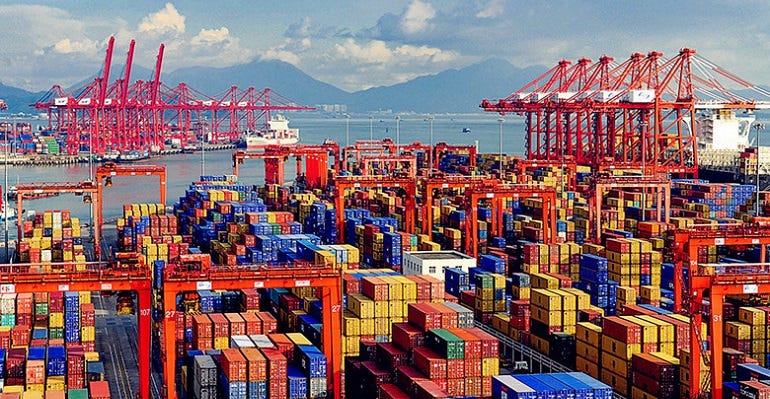About 90% of the world’s foreign trade is carried out through the sea. China is the world’s largest exporter of goods and 7 of the 10 largest ports in the world belong to China alone

The United Nations Conference on Trade and Development (UNCTAD) estimates that roughly 80 percent of global trade by volume and 70 percent by value is transported by sea.

Of that volume, 60 percent of maritime trade passes through Asia, with the South China Sea carrying an estimated one-third of global shipping.1 Its waters are particularly critical for China, Taiwan, Japan, and South Korea, all of which rely on the Strait of Malacca, which connects the South China Sea and, by extension, the Pacific Ocean with the Indian Ocean. As the second-largest economy in the world with over 60 percent of its trade in value traveling by sea, China’s economic security is closely tied to the South China Sea.
As a vital artery of trade for many of the world’s largest economies, the South China Sea has garnered significant attention. The high concentration of commercial goods flowing through the relatively narrow Strait of Malacca has raised concerns about its vulnerability as a strategic chokepoint. Writings on the South China Sea frequently claim that $5.3 trillion worth of goods transits through the South China Sea annually, with $1.2 trillion of that total accounting for trade with the U.S. This $5.3 trillion figure has been used regularly since late 2010, despite significant changes in world trade over the last five-plus years
Introduction
China has long been the world’s factory, producing an overwhelming share of the world’s products. But it’s not just the factories or workers that make this feat possible – it’s also the ports.
From the bustling port of Shanghai to the fast-growing port of Dalian, China’s ports are the lifeblood of its export-oriented economy.
These ports handle an enormous amount of cargo traffic, connecting the country to the rest of the world and enabling it to sustain its position as a global economic superpower.
In this blog post, we will take a closer look at the 10 busiest shipping ports in China, delving into their history, location, capacity, and their significance in the global trade network.
1. Port of Shanghai

Location: Shanghai Province
Chinese name: 上海港
Volume 2020 (Million TEU): 43.5

Port of Shanghai
2. Port of Ningbo-Zhoushan

Location: Zhejiang Province
Chinese name: 宁波舟山港
Volume 2020 (Million TEU): 28.72

Port of Ningbo-Zhoushan
3. Port of Shenzhen

Location: Guangdong Province
Chinese name: 深圳港
Volume 2020 (Million TEU): 26.55

Port of Shenzhen
4. Port of Guangzhou

Location: Guangdong Province
Chinese name: 广州港
Volume 2020 (Million TEU): 23.19

Port of Guangzhou
5. Port of Qingdao
Location: Shandong Province
Chinese name: 董家口
Volume 2020 (Million TEU): 22.00

Port of Qingdao
6. Port of Tianjin
Location: Tianjin Municipality
Chinese name: 天津港
Volume 2020 (Million TEU): 18.35

Port of Tianjin
7. Port of Hong Kong
Location: Hong Kong Special Administrative Region
Chinese name: 香港港口
Volume 2020 (Million TEU): 17.95

 Port of Hong Kong
Port of Hong Kong
8. Port of Xiamen
Location: Fujian Province
Chinese name: 厦门港
Volume 2020 (Million TEU): 11.41

Port of Xiamen
9. Port of Dalian
Location: Liaodong Province
Chinese name: 大连港
Volume 2020 (Million TEU): 6.54

Port of Dalian
10. Port of Yingkou
Location: Liaoning Province
Chinese name: 营口港
Volume 2020 (Million TEU): 5.67

Port of Yingkou